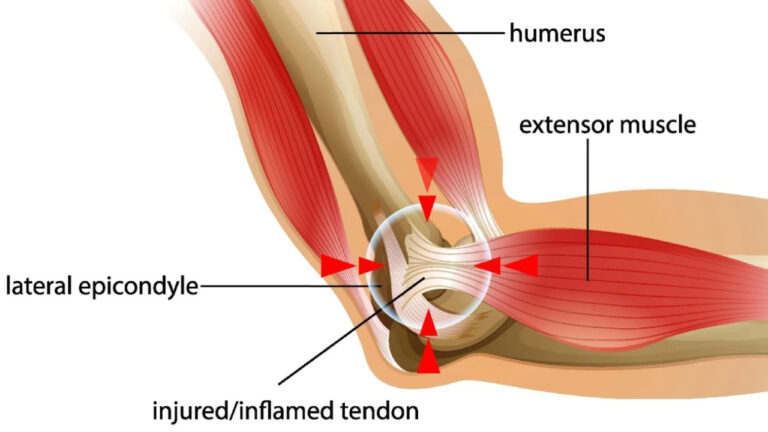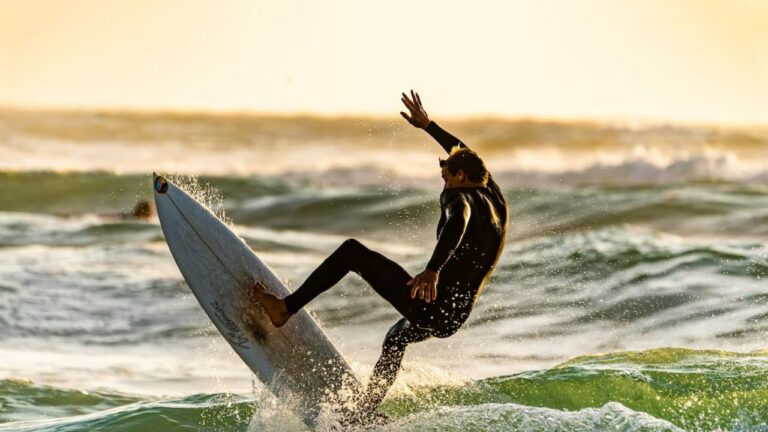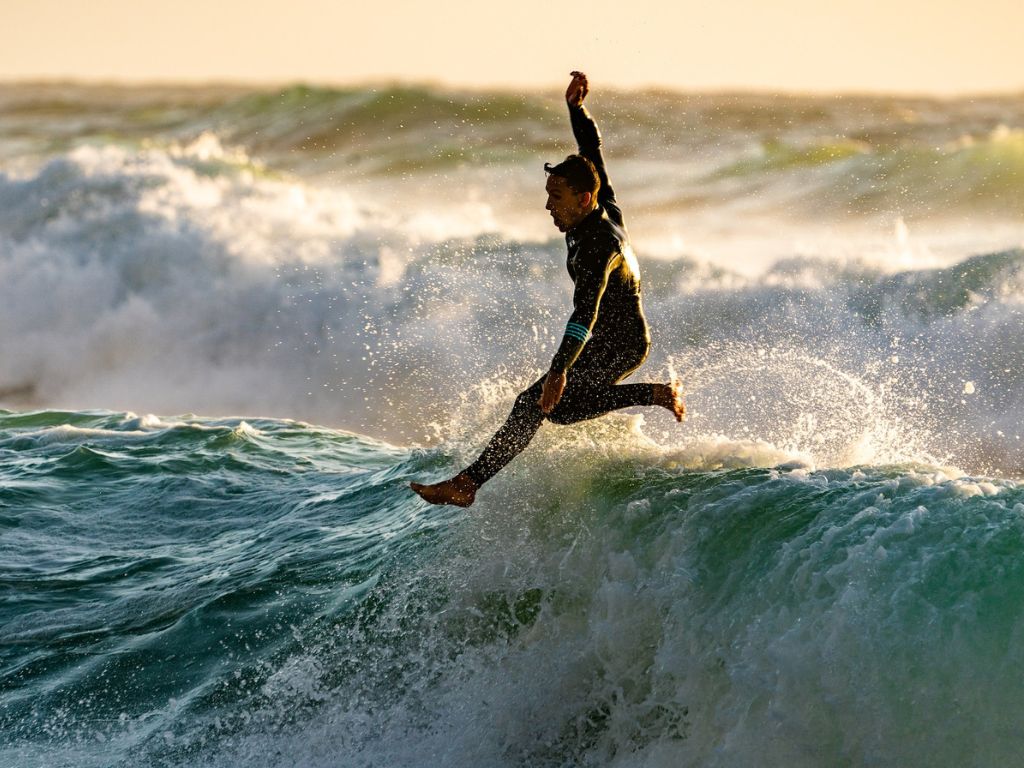Surfing is a popular water sport enjoyed by people of all ages and skill levels worldwide. However, several myths and rumors about the potential health risks associated with surfing are floating around.
So, I have decided to closely examine some of the most common issues people associate with surfing. From tennis elbow to vertigo, sinus infections to brain damage, we’ll examine the evidence and separate fact from fiction.
Whether you’re an avid surfer or just curious about the sport, join me as we explore the truth behind these common myths. And discover what you need to know to stay safe and healthy out on the waves.
1. Can surfing cause tennis elbow?

It’s a condition that occurs when the tendons in the elbow become inflamed or damaged, causing pain and discomfort. The tennis elbow is a common injury among athletes who engage in repetitive arm movements, such as tennis players, golfers, and weightlifters.
One question surfers may have is whether surfing can cause or contribute to developing tennis elbow. And the answer to that is yes.
Surfing, which involves repetitive arm and shoulder movements, has the potential to cause tennis elbow. However, repetitive movements in surfing, such as paddling and popping up on the board, aren’t typically associated with developing tennis elbow.
First, it’s important to understand that tennis elbow is typically caused by overuse of the forearm muscles and tendons. That means everything boils down to your preparation.
Are you doing proper warm-up and cool-down? Are you applying the proper technique? If not, the physical demands of surfing can strain the muscles and tendons in the arms and elbows. Over time, this strain can lead to injury or discomfort.
If a surfer does experience pain or discomfort in the arms or elbows, it’s important to seek medical attention and rest the affected area. Physical therapy or other treatments are sometimes necessary to promote healing and prevent further injury.
I have a detailed guide on this if you want to know more:
2. Can surfing cause vertigo?

Vertigo is a feeling of dizziness or spinning, often accompanied by nausea or a loss of balance. But can surfing cause vertigo? First, let’s define vertigo.
Vertigo is a specific type of dizziness that is characterized by the sensation of spinning or movement, even when the body is stationary.
It can be caused by a dysfunction of the inner ear, which maintains our sense of balance. Other causes include problems with the vestibular nerve or the brainstem, certain medications, or head injuries.
While there is limited research on the topic specifically related to surfing, evidence suggests that certain activities can exacerbate pre-existing conditions that cause vertigo. For example, rapid head movements, such as those involved in gymnastics or diving, have triggered vertigo in some people.
There’s no concrete evidence that suggests surfing is a direct cause of vertigo. In fact, a study published in the Journal of Sports Science and Medicine found that surfers had better balance and stability than non-surfers.
It’s likely because surfing requires high balance and coordination, which can help strengthen the vestibular system. That being said, it is important to note that surfing can exacerbate pre-existing conditions that cause vertigo.
Suppose a person already has an inner ear problem or a vestibular disorder. In that case, the movements involved in surfing could trigger or worsen their symptoms.
It’s also possible that certain environmental factors, such as changes in water pressure or temperature, could affect the inner ear and lead to vertigo.
If you want to know more or how to combat this isse, I have a separate article dedicated to that:
3. Can surfing cause a sinus infection?
Sinus infections are a common health problem that affects millions of people worldwide.
A sinus infection, or sinusitis, is an inflammation of the sinus cavities. Sinus cavities are hollow spaces located within the facial bones, which are lined with mucous membranes.
When these membranes become inflamed, they can produce excessive mucus, leading to congestion, pressure, and pain in the face, head, and ears. Sinus infections can be caused by various factors, such as allergies, viruses, bacteria, or fungi.
When it comes to surfing, one of the ways that water can enter the sinus cavities is through the nose. When a surfer falls off the board or wipes out, they may inhale water forcefully through their nostrils, leading to water retention in the sinus cavities.
This water can create a breeding ground for bacteria or viruses, leading to a sinus infection. Furthermore, the water’s cold temperature can also constrict blood vessels, reducing the blood supply to the nasal tissues and making them more vulnerable to infections.
Research suggests that surfing can contribute to developing a sinus infection. A study published in the Journal of Laryngology and Otology investigated the prevalence of sinusitis among surfers in the UK. They that 19.4% of the surveyed surfers reported symptoms consistent with sinusitis.
The researchers suggested that exposure to cold water and inhaling seawater droplets may have contributed to the high incidence of sinusitis among surfers.
Another study published in the American Journal of Otolaryngology-Head and Neck Medicine and Surgery investigated the effect of surfing on nasal function.
The study found that surfers had significantly lower nasal flow rates than non-surfers, indicating a decreased ability to clear their nasal passages. The researchers suggested that this decreased nasal function could increase the risk of sinus infections among surfers.
Despite these findings, it’s essential to note that surfing is not a guaranteed cause of sinus infections. However, surfers can take some precautions to minimize the risk of developing a sinus infection.
For example, using a nasal rinse after surfing can help clear water or debris from the nasal passages. Additionally, wearing a wetsuit, a hood, or a nose clip can help protect the nasal tissues from cold water and seawater droplets.
If you want to know more or how to combat this isse, I have a separate article dedicated to that:
4. Can surfing cause brain damage?

One of the most common concerns surfers (and their loved ones) have is whether surfing can cause brain damage. The thing you gotta understand is that surfing, like other extreme sports, carries a certain risk.
Whether from the surfboard itself or the ocean’s natural elements, surfers can experience injuries like sprains, broken bones, and even head injuries. However, the question is whether surfing can specifically lead to brain damage.
According to the National Institute of Neurological Disorders and Stroke, traumatic brain injuries (TBIs) are caused by a bump, blow, or jolt to the head or a penetrating head injury that disrupts the brain’s normal function. TBIs range from mild (concussion) to severe (coma).
In the case of surfing, sustaining a head injury is possible, but the chances are negligible. It could happen from a collision with another surfer, hitting the ocean floor, or even getting hit by the surfboard.
The injury’s severity depends on the impact’s force and the type of object involved. For example, hitting your head on a soft wave may result in a mild concussion, while hitting your head on a hard surfboard can cause a more severe head injury.
However, the risk of sustaining a head injury while surfing is relatively low. In fact, a study conducted by the University of Hawaii found that the risk of head injury while surfing is only 0.6 per 1,000 surf sessions. This is significantly lower than the risk of head injury in other contact sports like football and soccer.
Another factor to consider is the use of safety equipment while surfing. Most surfers wear a helmet to protect their heads from potential impacts. This can significantly reduce the risk of head injury while surfing.
In addition, surfers can also take other safety precautions, such as avoiding crowded surf spots and wearing a leash to prevent their surfboard from becoming a hazard.
5. Can surfing cause sciatica?

Sciatica is a painful condition that affects the sciatic nerve, the largest nerve in the body. But can surfing cause sciatica? Or can it aggravate the problem?
Since I haven’t had back pain during surfing (THANK GOD), I took a beeline for Reddit to understand sciatica and its causes among surfers better.
It’s caused by compression or irritation of the sciatic nerve, which can be due to a herniated disc, spinal stenosis, or other conditions that affect the spine. Symptoms include pain, tingling, and numbness in the lower back, buttocks, and legs.
When it comes to surfing, the sport involves a lot of movement and physical activity that can stress the lower back and hips. Paddling, standing on the board, and making quick turns require core strength and stability. This can lead to strain and tightness in the lower back and hips, exacerbating existing sciatica or even causing it.
However, that’s not enough.
Surfing does not cause sciatica. But, it can worsen existing sciatica or contribute to the development of the condition in individuals who are already predisposed to it. If you have a history of sciatica or other lower back problems, you may be at a higher risk while surfing.
That being said, there are ways to reduce the risk of sciatica while surfing. Strengthening the core muscles through exercises like planks and bridges can help to stabilize the lower back and hips.
Additionally, practicing good posture while surfing and taking stretch breaks can help alleviate strain or tightness in the lower back and hips. You can learn more about that in this guide:
6. Can surfing cause tinnitus?

Tinnitus is characterized by a ringing or buzzing sound. The condition is caused by damage to the hair cells in the inner ear, which can be due to exposure to loud noises, head or neck injuries, or other factors that affect the ear.
Surfing is not known to explicitly cause tinnitus (ear ringing). However, exposure to loud noises, such as those from crashing waves, wind, and machinery used in surfing, can lead to tinnitus if proper ear protection is not worn.
However, it is important to note that surfing doesn’t necessarily cause tinnitus. Rather, it is the exposure to loud noises that can cause or worsen the condition.
Surfers who spend much time in the water may also risk developing a surfer’s ear, a condition caused by repeated exposure to cold water and wind. This can lead to the growth of bony growths in the ear canal, which can cause hearing loss and make it more difficult to hear.
Fortunately, there are ways to reduce the risk of tinnitus and a surfer’s ear while surfing. Wearing earplugs can help to protect the ears from loud noises and cold water. Additionally, taking breaks to warm up and dry off can help to reduce the risk of developing a surfer’s ear.
Read More
7. Can surfing cause miscarriage?

The topic of miscarriage is serious and sensitive, and it is important to approach it with care and empathy. Miscarriage is a term used to describe the loss of a pregnancy before the 20th week.
One question some of my pregnant readers may have is whether surfing can cause or contribute to miscarriage. Fortunately, it doesn’t.
There is currently no evidence to suggest that surfing can cause miscarriage. However, pregnant women are advised to avoid physical activities that may cause injury or abdominal trauma, such as surfing, to minimize the risk of pregnancy complications.
One of the biggest risks of surfing during pregnancy is the potential for injury.
A fall from a surfboard or a collision with another surfer can potentially cause injury to the mother and the developing fetus. Additionally, exposure to cold water and strong currents can put additional stress on the body, potentially leading to pregnancy complications.
Another risk of surfing during pregnancy is the potential for exposure to harmful substances. Water pollution, including sewage and industrial waste, can cause harm to the developing fetus.
Additionally, exposure to harmful chemicals and toxins, such as those found in surfboard wax and other surf-related products, can cause harm to the developing fetus. Given these risks, pregnant women should take caution when considering surfing during pregnancy.
It is important to consult with your healthcare provider before engaging in a physical activity. In some cases, avoiding surfing altogether during pregnancy may be recommended.
8. Can surfing cause skin cancer?

Medical research shows a significant association between surfing and an increased risk of developing skin cancer.
The primary cause of skin cancer from surfing is exposure to UV radiation from the sun. UV radiation damages skin cells and causes mutations that can lead to skin cancer. Due to prolonged exposure to the water, surfers are more likely to get sunburn and skin damage.
How exactly does this work, you ask? UV radiation can damage the DNA in skin cells, which can cause them to grow uncontrollably and form tumors. Surfing involves spending long periods in direct sunlight, which can increase the risk of UV exposure and potentially contribute to the development of skin cancer.
Melanoma is the most serious form of skin cancer and can be fatal if not detected and treated early. It’s important for surfers to be aware of skin cancer’s signs and symptoms and seek medical attention if they notice any changes in their skin.
In addition to taking precautions to protect their skin from UV radiation, surfers can also reduce their risk of developing skin cancer by regularly checking their skin for any changes or abnormalities.
It’s recommended that individuals perform self-examinations of their skin monthly and visit a dermatologist for a full skin exam at least once a year.





